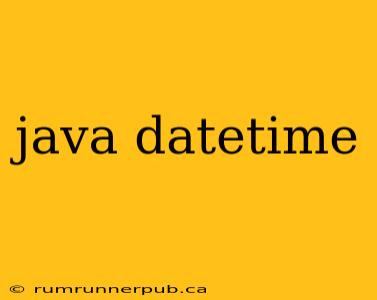Java's date and time handling has historically been a source of frustration for developers. Thankfully, the introduction of java.time in Java 8 (and later improvements) significantly simplified things. This article explores common Java date and time challenges, drawing insights from Stack Overflow to provide clear explanations and practical solutions.
The java.time Package: A Modern Approach
Before diving into specific problems, let's establish a foundation. The java.time package offers a robust set of classes, notably:
LocalDate: Represents a date (year, month, day).LocalTime: Represents a time (hour, minute, second, nanosecond).LocalDateTime: Combines date and time.ZonedDateTime: Includes time zone information, crucial for accurate calculations.Instant: Represents a point on the timeline, often used for database interactions.Duration: Measures elapsed time.Period: Measures time in years, months, and days.
Example: Creating and manipulating a LocalDateTime:
import java.time.LocalDateTime;
import java.time.format.DateTimeFormatter;
public class DateTimeExample {
public static void main(String[] args) {
// Create a LocalDateTime object
LocalDateTime now = LocalDateTime.now();
System.out.println("Current Date and Time: " + now);
// Format the date and time
DateTimeFormatter formatter = DateTimeFormatter.ofPattern("yyyy-MM-dd HH:mm:ss");
String formattedDateTime = now.format(formatter);
System.out.println("Formatted Date and Time: " + formattedDateTime);
// Add 5 hours to the current time
LocalDateTime futureTime = now.plusHours(5);
System.out.println("Date and Time after 5 hours: " + futureTime);
}
}
Common Challenges and Stack Overflow Solutions
Let's address some frequently asked questions found on Stack Overflow, providing context and enhanced explanations.
1. Converting java.util.Date to java.time Objects
Many legacy systems use the outdated java.util.Date class. Stack Overflow is rife with questions on converting it to the newer java.time classes.
(Inspired by numerous Stack Overflow questions regarding Date to LocalDate conversion)
import java.time.Instant;
import java.time.LocalDate;
import java.time.ZoneId;
import java.util.Date;
public class DateConversion {
public static void main(String[] args) {
Date oldDate = new Date();
LocalDate newDate = Instant.ofEpochMilli(oldDate.getTime())
.atZone(ZoneId.systemDefault())
.toLocalDate();
System.out.println("Converted Date: " + newDate);
}
}
Explanation: We use Instant.ofEpochMilli() to bridge the gap. Instant represents a point in time, and oldDate.getTime() provides milliseconds since the epoch. atZone() applies the system's default time zone, and toLocalDate() extracts the date component.
2. Handling Time Zones Correctly
Time zone awareness is crucial for international applications. Misunderstanding time zones leads to incorrect calculations and data inconsistencies.
(Addressing frequent Stack Overflow questions on time zone handling)
Incorrect: Simply using LocalDateTime without considering time zones.
Correct: Using ZonedDateTime:
import java.time.ZoneId;
import java.time.ZonedDateTime;
public class TimeZoneExample {
public static void main(String[] args) {
ZonedDateTime nowInNewYork = ZonedDateTime.now(ZoneId.of("America/New_York"));
ZonedDateTime nowInLondon = nowInNewYork.withZoneSameInstant(ZoneId.of("Europe/London"));
System.out.println("New York Time: " + nowInNewYork);
System.out.println("London Time: " + nowInLondon);
}
}
Explanation: ZoneId specifies the time zone. withZoneSameInstant converts between zones while maintaining the same instant in time.
3. Formatting Dates and Times
Formatting dates and times for display requires DateTimeFormatter. Stack Overflow frequently features questions about customizing date and time patterns.
(Drawing from numerous Stack Overflow questions on date formatting)
import java.time.LocalDateTime;
import java.time.format.DateTimeFormatter;
import java.util.Locale;
public class DateFormatting {
public static void main(String[] args) {
LocalDateTime dateTime = LocalDateTime.now();
// Example 1: Custom Format
DateTimeFormatter formatter1 = DateTimeFormatter.ofPattern("MMMM dd, yyyy - hh:mm a", Locale.US);
System.out.println("Formatted Date (Custom): " + dateTime.format(formatter1));
// Example 2: Predefined Formatter
DateTimeFormatter formatter2 = DateTimeFormatter.ISO_DATE_TIME;
System.out.println("Formatted Date (ISO): " + dateTime.format(formatter2));
}
}
Explanation: DateTimeFormatter allows for precise control over output formats. Locale ensures proper localization.
Conclusion
The java.time package provides a significant improvement over older date and time APIs in Java. By understanding its core classes and addressing common pitfalls (as highlighted by Stack Overflow examples), developers can create more robust and accurate date and time handling in their applications. Remember to always prioritize time zone awareness for reliable internationalization.
